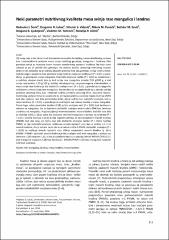Neki parametri nutritivnog kvaliteta mesa svinja rase mangulica i landras

View/
Date
2017Author
Šević, Radoslav
Lukač, Dragomir
Vidović, Vitomir
Puvača, Nikola
Savić, Božidar
Ljubojević, Dragana
Tomović, Vladimir
Džinić, Natalija
Metadata
Show full item recordAbstract
The aim of this study was to provide a comparative analysis of chemical and
fatty acid composition, as well as of the connective tissue proteins in pigs of
different genotypes, Mangalitsa and Landrace. Both pig genotypes were fed with
the same feed of standard composition and quality. At the end of the fattening
period, in total 24 pigs of both genotypes were slaughtered. Based on the analysis
of the chemical composition we came to the conclusion that the protein content
in both genotypes was similar. Moisture and ash content in the Landrace pig
genotype differed significantly (P < 0.01) compared with genotype of Mangalitsa
breed. Statistically significant differences (P < 0.01) were established in the fat
content, which was 7.95 g/100 g, in pigs of Mangalitsa breed and 1.59 g/100 g in
the Landrace pigs breed. Content of hydroxyproline, non-proteinogenic amino
acids, in meat of Landrace was significantly higher (P < 0.01) compared to the
content in the Mangalitsa breed. The same tendency was observed with regard to
the connective tissue protein content, as well as with the relative connective tissue protein content. The fatty acid composition of the meat indicated that the
most common saturated fatty acid (SFA) in both tested breeds was palmitic fatty
acid (C16), whose content was significantly higher in Landrace (P < 0.01) compared with its content in Mangalitsa breed. In addition, the share of stearic acid
(C18) was significantly higher (P < 0.01) in Landrace compared to Mangalitsa pig
breed, what significantly contributed to the increase of the SFA share in Landrace
compared to Mangalitsa breed. The most common monounsaturated fatty acid in
both pig breeds was the oleic fatty acid (C18:1), whose share was significantly
higher in Mangalitsa compared to the Landrace breed (P < 0.01). Out of the polyunsaturated fatty acids (PUFA), linoleic fatty acid (C18:2) was the most predominant in both pig breeds, with no statistically significant differences (P > 0.05). The
content of PUFA was not statistically significantly different between the tested
breeds, as well as the content of n-3 and n-6 fatty acids, which caused no statistically significant differences in the n-6/n-3 PUFA ratio. Ratio of the unsaturated
fatty acids, i.e., of the sum of MUFA and PUFA, and of the saturated fatty acids
was significantly higher in Mangalitsa compared to Landrace breed (1.86 vs. 1.4),
and the same was observed when it comes to the relationship MUFA/SFA (1.51 in
Mangalitsa vs. 1.08 in Landrace breed) and MUFA/PUFA (4.35 vs. 3.38).
